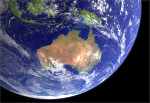My interest in Astrophysics and Astrononomy started way back in 1946.
A comet approached the Solar System and was clearly visible around midnight here in Melbourne,
low in the western sky.
My Dad showed me this comet - we saw it from a laneway which was adjacent to our back fence,
in Auburn.
In 1950 I bought a telescope - this was about 2 ft long and 2" diameter.
From our back yard in Auburn I saw many celestial objects, including thd Moon, Saturn and its rings, Jupiter and its moons,
Mars, Venus and Mercury.
In 1956 I upgraded to a large refkecting telescope with azimuth
mount - this was about 1 metre long, 6 " mirror, on a tripod, with a small sighting telescope.
From Auburn, I studied the universe, parfticularly the brilliant colors of the various
nebulae.
In 1956, I completed a two month evening course "Introduction to Astronomy",
at the Swinburne Institute of Techology (now known as Swinburne University), in Hawthorn. On ths roof of the Science building
was a very large refracting telescope, which allowd us to observe lots of astronomical objecrs. This instrument was about
3 metres long and about 1 metre in diameter.
1957 - Sputnik 1 was the first artificial satellite to be put into Earth's orbit. It was launched into an elliptical low Earth oprbit by the Soviet Union on 4 October 1957.
The unanticipated announcement of Sputnik 1's success precipitated the Sputnik crisis in the United States and ignited the Space Race, a part of the larger Cold War. The launch ushered in new political, military, technological,
and scientific developments. While the Sputnik launch was a single event, it marked the start of the Space Age.
Apart from its value as a technological first, Sputnik also helped to identify the upper
atmospheric layer's density, through measuring the satellite's orbital changes. It
also provided data on radio-signal distribution in the ionosphere.
Pressurized nitrogen in the satellite's body provided the
first opportunity for meteorid detection. If a meteoroid penetrated the satellite's outer
hull, it would be detected by the temperature data sent back to Earth
Sputnik 1 was launched during the Internatiomal Geopysical Year from Site No. 1/5, at the 5th Tyuratam,
in azhk SSR (now at the Baikonur Cosmodrome)). The satellite
travelled at 29,000 kilometers (18,000 mi) per hour, taking 96.2 minutes to complete an orbit, and emitted radio signals
at 20.005 and 40.002 MHz which were monitored by amateur radioo operators throughout the world. The signals continued for 22 days until the transmitter batteries
ran out on 26 October 1957. Sputnik 1 burned up on 4 January 1958, as it fell from orbit upon reentering Earth's atmosphere, after travelling about 60 million km (37 million miles) and spending 3 months in orbit.
The transmmssions on 20.005 MHz were easily heard here in Melbourne, as Sputnik pssed overhead
in its low orbit.
In 1957, I signed up for a three month evening course in Astronomy, conducted
by the the Council of Adult Education, in the city.
When we moved to our new home in Mont Albert in 1959, serious astronomical workl was limited
due to visual pollution from street lighting, which meant that my interest in practical astronom came to an end, and I sold
the telescope in the early 1960s.
July 21, 1969 was the date of the first moonlanding. At the time I was working in the PMG's Engineering Workshops in South Melbnourne. As there was no
TV set in our office, some of us walked across the road to the Philip's factory, where we knew some of the engineers there.
We watched the landing on TV there, and those of us who were around at that time will recall the first images of Neil
Amstrong's bouncy touchdown, which were upside down! Australian imaging originated from the deep-space tracking station at
Tidbinbilla, near Canberra.
In 1976, I visited the North American Space Administration centre in Florida,
seeing first-hand the equipment and facilities usd in the Apollo flights.
In 2008, I signed up for a part-time 12-week evening course in Astrophysics
at Swinburne University. This requited engineering, mathemetical and electronics knowledge, as assignments were set to
reinforce the concepts introduced in the lectures.
By that time, SUT had become onf of the leading-edge Astrophysics centres in Australia, and
we were shown some amazing imaging, some in real time, on a huge iMax screen, orginating from deep space-tracking facilities
worldwide.

